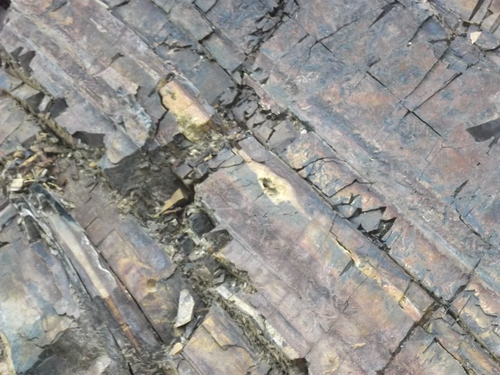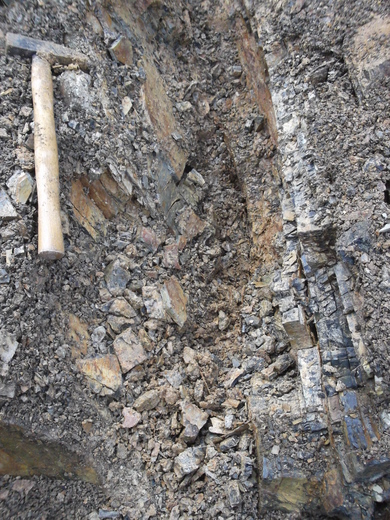Bishop's Tawton, North Devon, Devon, England, UKi
| Regional Level Types | |
|---|---|
| Bishop's Tawton | - not defined - |
| North Devon | District |
| Devon | County |
| England | Constituent Country |
| UK | Country |
This page is currently not sponsored. Click here to sponsor this page.
Neighbouring regions:
Bishop's Tawton is a village and civil parish in the North Devon district of Devon, England. It is in the valley of the River Taw, about three miles south of Barnstaple.
The village sits at the foot of the western end of Codden Hill, the name locality for the Carboniferous Codden Hill Cherts, a complex of marine deep-trench deposits generally depleted of carbonates but in which phosphatic nodules abound.
The exposure of the Codden Hill Cherts extends westward as a series of low hills, finally disappearing at the coast, and extends eastward as far as South Molton. The exposure comes to surface as a series of E-W trending folds.
The beds extend below the surface for an unknown distance to the south and are eroded completely to the north.
The cherts are sparsely fossiliferous though are noted for the presence of phosphate minerals, in particular Wavellite (TL at Filleigh, to the east of Codden Hill).
Select Mineral List Type
Standard Detailed Gallery Strunz Chemical ElementsCommodity List
This is a list of exploitable or exploited mineral commodities recorded from this region.Mineral List
Mineral list contains entries from the region specified including sub-localities8 valid minerals.
Rock Types Recorded
Note: data is currently VERY limited. Please bear with us while we work towards adding this information!
Rock list contains entries from the region specified including sub-localities
Select Rock List Type
Alphabetical List Tree DiagramDetailed Mineral List:
| ⓘ Beraunite ? Formula: Fe3+6(PO4)4O(OH)4 · 6H2O Habit: Massive, bladed masses. Colour: reddish-brown to clove brown Description: Some reddish-brown areas of a small number of specimens show the bladed forms resembling those of eleonorite.
Further work is required for confirmation. Reference: Alysson Rowan Collection |
| ⓘ Cacoxenite Formula: Fe3+24AlO6(PO4)17(OH)12 · 75H2O Habit: massive, botryoidal, encrusting Colour: yellow Description: Cacoxenite is found as a bright yellow encrustation in fractures in the rock of the quarry, often in association with porous quartz veins.
Where it is found, it is locally abundant but is absent through most of the quarry.
Larger plates showing the phosphatic mineralisation vary across the suface between clove-brown and bright yellow, occasionally to orange and red. The cacoxenite is generally between a deep yellow-brown and bright yellow. Reference: Alysson Rowan Collection |
| ⓘ 'Manganese Oxides' Reference: Alysson Rowan Collection |
| ⓘ 'Manganese Oxides var. Manganese Dendrites' Habit: Dendritic - coarsely crystalline to lacy dendritic encrustations. Colour: Black Description: The development of manganese dendrites is particularly varied in this quarry - ranging from coarse, tangible crystals infilling fracture voids down to delicate, mossy developments across the siltstone surfaces.
In places, these developments do present a particular aesthetic appeal.
Reference: Alysson Rowan Collection |
| ⓘ Metavivianite ? Formula: Fe2+Fe3+2(PO4)2(OH)2 · 6H2O Habit: blased masses Colour: dark green Description: A few areas of phosphatic encrustation show the colour and approximate form of metavivianite.
Further work is required. Reference: Alysson Rowan Collection |
| ⓘ Opal Formula: SiO2 · nH2O Reference: Alysson Rowan Collection |
| ⓘ Opal var. Common Opal Formula: SiO2 · nH2O Habit: none: massive Colour: white to off-white Fluorescence: none Description: Redeposited silica tubes formed in cracks in the Codden Hill Cherts which host a number of phosphate species.
These thin-walled tubes appear to have formed in much the same way as speleothem 'straws', and various walls and ramifications appear across the rock surfaces. These same cracks also play host to the various phosphate minerals found at this location. Reference: Alysson Rowan Collection |
| ⓘ Rockbridgeite ? Formula: Fe2+Fe3+4(PO4)3(OH)5 Reference: Alysson Rowan Collection |
| ⓘ Strengite ? Formula: FePO4 · 2H2O Habit: botryoidal, encrusting; massive Colour: pale purple Description: Areas of purple phosphatic encrustations strongly resemble strengite. Reference: Alysson Rowan Collection |
| ⓘ Variscite ? Formula: AlPO4 · 2H2O Habit: botryoidal; encrusting Colour: white Description: Tiny, pale hemispheres and white encrustations have been tentatively placed as variscite.
Variscite has been previously reported (unconfirmed) from this location. Reference: Alysson Rowan Collection |
| ⓘ Wavellite Formula: Al3(PO4)2(OH,F)3 · 5H2O Habit: Radial hemispheres, botryoidal Colour: bottle green to black Description: Small clusters of generally dark hemispheres lining a cavity formerly filled with phosphatic clay. Other minerals peresent in this specimen are manganese oxides, cacoxenite and other unidentified (phosphate) minerals.
The specimen was removed in the process of extracting cacoxenite plates from the quarry wall. Reference: Alysson Rowan Collection |
List of minerals arranged by Strunz 10th Edition classification
| Group 4 - Oxides and Hydroxides | |||
|---|---|---|---|
| ⓘ | Opal | 4.DA.10 | SiO2 · nH2O |
| ⓘ | var. Common Opal | 4.DA.10 | SiO2 · nH2O |
| Group 8 - Phosphates, Arsenates and Vanadates | |||
| ⓘ | Beraunite ? | 8.DC.27 | Fe3+6(PO4)4O(OH)4 · 6H2O |
| ⓘ | Cacoxenite | 8.DC.40 | Fe3+24AlO6(PO4)17(OH)12 · 75H2O |
| ⓘ | Metavivianite ? | 8.DC.25 | Fe2+Fe3+2(PO4)2(OH)2 · 6H2O |
| ⓘ | Rockbridgeite ? | 8.BC.10 | Fe2+Fe3+4(PO4)3(OH)5 |
| ⓘ | Strengite ? | 8.CD.10 | FePO4 · 2H2O |
| ⓘ | Variscite ? | 8.CD.10 | AlPO4 · 2H2O |
| ⓘ | Wavellite | 8.DC.50 | Al3(PO4)2(OH,F)3 · 5H2O |
| Unclassified Minerals, Rocks, etc. | |||
| ⓘ | 'Manganese Oxides' | - | |
| ⓘ | 'var. Manganese Dendrites' | - | |
List of minerals for each chemical element
| H | Hydrogen | |
|---|---|---|
| H | ⓘ Opal | SiO2 · nH2O |
| H | ⓘ Cacoxenite | Fe243+AlO6(PO4)17(OH)12 · 75H2O |
| H | ⓘ Wavellite | Al3(PO4)2(OH,F)3 · 5H2O |
| H | ⓘ Opal var. Common Opal | SiO2 · nH2O |
| H | ⓘ Rockbridgeite | Fe2+Fe43+(PO4)3(OH)5 |
| H | ⓘ Beraunite | Fe63+(PO4)4O(OH)4 · 6H2O |
| H | ⓘ Strengite | FePO4 · 2H2O |
| H | ⓘ Metavivianite | Fe2+Fe23+(PO4)2(OH)2 · 6H2O |
| H | ⓘ Variscite | AlPO4 · 2H2O |
| O | Oxygen | |
| O | ⓘ Opal | SiO2 · nH2O |
| O | ⓘ Cacoxenite | Fe243+AlO6(PO4)17(OH)12 · 75H2O |
| O | ⓘ Wavellite | Al3(PO4)2(OH,F)3 · 5H2O |
| O | ⓘ Opal var. Common Opal | SiO2 · nH2O |
| O | ⓘ Rockbridgeite | Fe2+Fe43+(PO4)3(OH)5 |
| O | ⓘ Beraunite | Fe63+(PO4)4O(OH)4 · 6H2O |
| O | ⓘ Strengite | FePO4 · 2H2O |
| O | ⓘ Metavivianite | Fe2+Fe23+(PO4)2(OH)2 · 6H2O |
| O | ⓘ Variscite | AlPO4 · 2H2O |
| F | Fluorine | |
| F | ⓘ Wavellite | Al3(PO4)2(OH,F)3 · 5H2O |
| Al | Aluminium | |
| Al | ⓘ Cacoxenite | Fe243+AlO6(PO4)17(OH)12 · 75H2O |
| Al | ⓘ Wavellite | Al3(PO4)2(OH,F)3 · 5H2O |
| Al | ⓘ Variscite | AlPO4 · 2H2O |
| Si | Silicon | |
| Si | ⓘ Opal | SiO2 · nH2O |
| Si | ⓘ Opal var. Common Opal | SiO2 · nH2O |
| P | Phosphorus | |
| P | ⓘ Cacoxenite | Fe243+AlO6(PO4)17(OH)12 · 75H2O |
| P | ⓘ Wavellite | Al3(PO4)2(OH,F)3 · 5H2O |
| P | ⓘ Rockbridgeite | Fe2+Fe43+(PO4)3(OH)5 |
| P | ⓘ Beraunite | Fe63+(PO4)4O(OH)4 · 6H2O |
| P | ⓘ Strengite | FePO4 · 2H2O |
| P | ⓘ Metavivianite | Fe2+Fe23+(PO4)2(OH)2 · 6H2O |
| P | ⓘ Variscite | AlPO4 · 2H2O |
| Fe | Iron | |
| Fe | ⓘ Cacoxenite | Fe243+AlO6(PO4)17(OH)12 · 75H2O |
| Fe | ⓘ Rockbridgeite | Fe2+Fe43+(PO4)3(OH)5 |
| Fe | ⓘ Beraunite | Fe63+(PO4)4O(OH)4 · 6H2O |
| Fe | ⓘ Strengite | FePO4 · 2H2O |
| Fe | ⓘ Metavivianite | Fe2+Fe23+(PO4)2(OH)2 · 6H2O |
Geochronology
Mineralization age: Carboniferous : 341 Ma to 326.4 ± 1.6 MaImportant note: This table is based only on rock and mineral ages recorded on mindat.org for this locality and is not necessarily a complete representation of the geochronology, but does give an indication of possible mineralization events relevant to this locality. As more age information is added this table may expand in the future. A break in the table simply indicates a lack of data entered here, not necessarily a break in the geologic sequence. Grey background entries are from different, related, localities.
| Geologic Time | Rocks, Minerals and Events | |||||||||||||||||||||
|---|---|---|---|---|---|---|---|---|---|---|---|---|---|---|---|---|---|---|---|---|---|---|
| Phanerozoic | ||||||||||||||||||||||
| Paleozoic | ||||||||||||||||||||||
| Carboniferous | ||||||||||||||||||||||
| Mississippian |
| |||||||||||||||||||||
Fossils
This region is too big to display the fossil list, try looking at smaller subregions.Localities in this Region
- England
- Devon
- North Devon
- Bishop's Tawton
- North Devon
- Devon
Other Regions, Features and Areas that Intersect
British and Irish IslesGroup of Islands
Eurasian PlateTectonic Plate
UK
- England
- Devon and Cornwall metalliferous mining districtMining District
This page contains all mineral locality references listed on mindat.org. This does not claim to be a complete list. If you know of more minerals from this site, please register so you can add to our database. This locality information is for reference purposes only. You should never attempt to
visit any sites listed in mindat.org without first ensuring that you have the permission of the land and/or mineral rights holders
for access and that you are aware of all safety precautions necessary.















Downrew Quarry, Bishop's Tawton, North Devon, Devon, England, UK